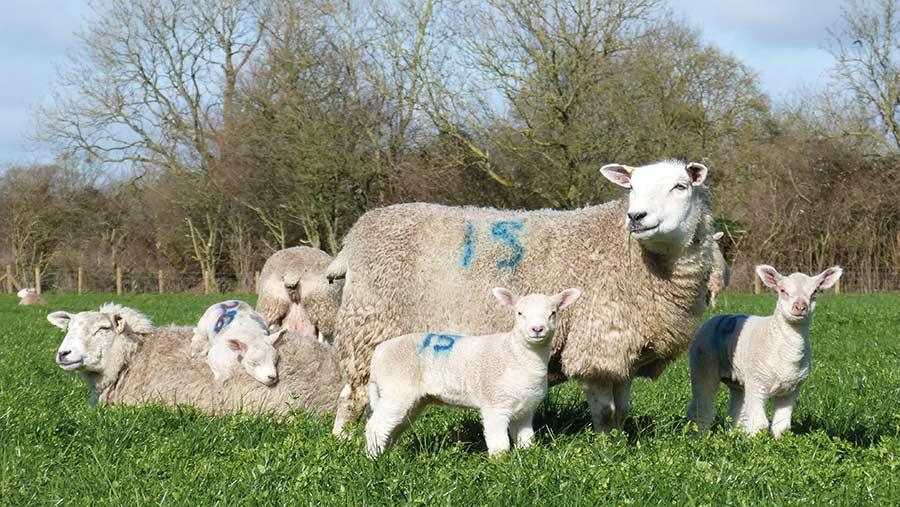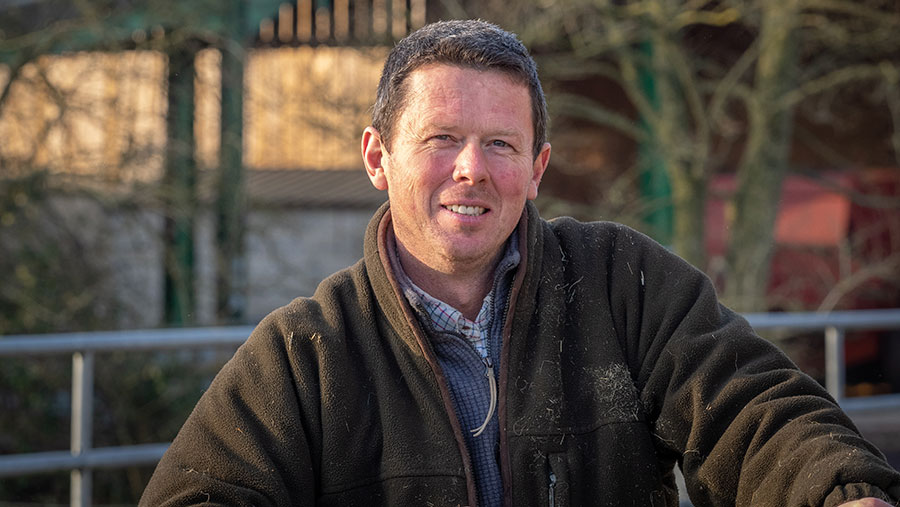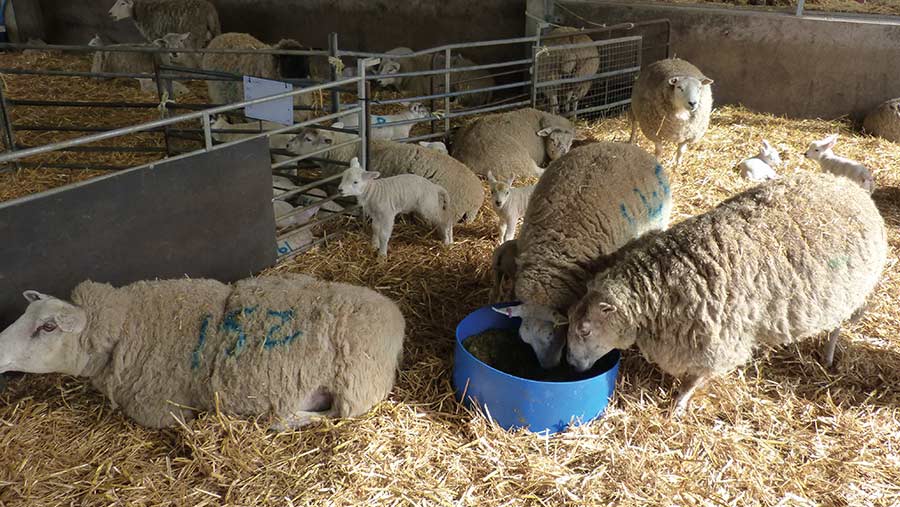How Texel system aims for £100 a ewe gross margin
 © MAG/Michael Priestley
© MAG/Michael Priestley Lowland farmers James and Belinda Kimber predict lower scanning rates and rising costs will pressure margins this year after hitting a gross margin of £155 a ewe in 2021.
The couple at Beanhill Farm, near Chippenham, Wiltshire, capitalised on a strong lamb price last year. But in 2022 the farm is struggling with rising costs and a lower scan result.
The commercial ewe flock is in its seventh year since the business took on rented ground in 2015, increasing the Kimbers’ farmed area by more than 50% to 92ha (228 acres).
See also: Trial finds ewe data is route to bigger lamb cheque
Farm facts
- 547 commercial Texel-cross ewes
- 200 pedigree Texel, Beltex, Charollais and Blue Texel ewes
- 44ha (108 acres) farmed at home, with 48ha (120 acres) rented
- Mix of permanent pasture, clover-rich leys, wintering crops and maize
- Pedigree cows: 12 Charolais, eight Simmentals
- Lambs sold at Worcester and Cirencester markets
- Lambs for two cycles from 5 March

James Kimber © Kathy Horniblow
Previously, the business ran 30 pedigree cows and 130 Texel ewes on the home farm, with Mr Kimber doing foot-trimming five-and-a-half days a week.
This paid for £500,000-worth of infrastructure and equipment on what was a derelict farm. Now foot-trimming is down to two days a week because of the extra work of the commercial sheep enterprise.
The 550 Texel cross Mules get no subsidy on the rented ground, but do pay a “lowish rent”, says Mrs Kimber.
Farmers Weekly asks how the flock performed last year and what the outlook is for 2022.

Ewes are fed a soya, maize and grass silage total mixed ration © MAG/Michael Priestley
2021 year in review: income and costs
2021 saw a very high scanning rate, which was not fully realised as lambs sold (see “Output and projected output at Beanhill Farm”).
Reasons for losses
- High scanning was caused by tupping 420 ewes on high-energy forage rape, which resulted in more triplets than twins
- Colostrum top-ups kept weak lambs going in the early stages, but a cold and frosty April challenged them further
- Eventually lost 70 30- to 50-day-old lambs in late April to clostridial challenge because of inadequate colostrum quality
Output and projected output at Beanhill Farm |
||
|
Metric |
2021 |
2022 |
|
Scanning |
225% (1,240 embryos) |
175% (980 embryos) |
|
Mortality |
12% from scanning, 130 lost |
8% (900 or 1.64 sold) |
|
Lamb value |
£108.29 a lamb (275p/kg) after all stoppages (£4.91 a lamb) |
£108 a lamb (budget) after stoppages for 41.2kg lamb |
|
Lamb cheque |
£110,466 (1,010 lambs, including 112 hoggets) |
£97,200 (predicted) |
|
Flock replacement |
|
|
|
Flock appreciation/depreciation |
|
|
|
Total income |
£146,213 (£110,466 + £11,000 + £24,747) |
£114,000 (£97,200 + £16,800) |
Some costs are lower this year, a result of a range of factors (see “Lower costs at Beanhill Farm in 2022”). However, this good news is tempered by a lower scanning rate and rising costs in other areas.
- Lower scan A knee-jerk reaction to a high scan last year resulted in 260 fewer embryos this time. Ewes were tupped on old grass leys in the autumn. There were also 100 ewe lambs in the scan, whereas last year all breeding sheep were ewes. Crucially, this limits numbers of lambs sold.
- Miscellaneous Latex gloves were £4.95 a box last year and now cost £17 and silage sheets and some medicines are much dearer.
- Flock replacement Last year’s income was skewed by culling so many ewes. There is £11,000 of capitalisation because the flock went from 550 to 450 ewes, as original purchase ewes were cashed in after starting the flock by buying over 300 ewes of the same age.
Costs of commercial sheep at Beanhill Farm in 2021 |
||
|
Variable costs |
Value |
Comments |
|
Lamb pellets |
£8,624 |
15% crude protein grower and finisher pellet |
|
Soya |
£5,391 |
Ration is 47.5% grass and maize, respectively, and 5% soya |
|
Ewe lambs |
£11,695 |
Texel cross Mules bought from a cousin |
|
Forage (seed, fertiliser, spray) |
£9,527 |
See “forage” in “Lower costs at Beanhill Farm in 2022”. |
|
Straw |
£2,630 |
180 six-string Hesston bales – 82t at £32/t |
|
Vet fees |
£1,178 |
Includes blood testing for metabolic profiles and only £180 for flock health plan as done with alongside cattle |
|
Contractor costs |
£8,000 |
Shared 50:50 with cows after cow straw was taken off |
|
Veterinary and medicines |
£5,866 (£10.70 a ewe) |
Includes enzootic and toxoplasmosis abortion vaccines |
|
Miscellaneous |
£7,803 |
Milk powder, latex gloves, iodine and so on |
|
Total variable costs |
£60,714 |
|
|
Gross margin |
£85,499 |
£155.45 a ewe (550 ewes) |
|
Fixed costs |
Value |
Comments |
|
Rent |
£7,297 |
120 acres at £40/acre, plus total winter keep costs |
|
Labour |
£2,450 |
One lambing helper |
|
Machinery |
£1,411 |
Quad bike depreciation (other depreciation is not accounted for) |
|
Wage |
£35,000 |
Wage for James and Belinda Kimber, although some wouldn’t cost this |
|
Total fixed costs |
£46,158 |
|
|
Enterprise profit |
£39,341 |
£71.52 a ewe |
Prognosis
The Kimbers are targeting a conservative gross margin of £100 a ewe for 2022, hoping returns increase when flock size recovers in 2023.
“Looking for positives, the lower scan means bigger lambs, which should be marketed at higher prices and the amount of shearling replacement ewes on farm insulates us from late summer breeding sales,” says Mr Kimber.
Ewes walking off the farm is vital, he says. Suffolk Mules were bought at £66 apiece to increase numbers, gave four crops and made £140 last year.
“Given huge uncertainty and volatility, we must be flexible, but producing high conformation, good-quality lambs is the best strategy for our scale. Depreciation isn’t accounted for here, but it’s difficult to know what’s happening. We bought a tractor and three months later we were offered £20,000 more than we’d paid for it – crazy times.”
Outlook for 2022
Some costs are lower this year, a result of a range of factors.
Lower costs at Beanhill Farm in 2022 |
||
|
Item |
2022 cost |
Comments |
|
Lamb pellets |
Bought forward at £277 thanks to a deal with feed company |
Slightly less needed due to lower scanning rate, so saving £2,504 on the year |
|
Soy |
£3,000 cost |
A lower scan means a saving of £1,200 on soya |
|
Pet lambs |
A scan of 225% led to 84 pet lambs last year and 50 bags of milk powder at £43.50/bag |
This year only three bags at £52/ bag for five pets. This has saved £2,019 |
|
Forage |
40% of the 2021 silage crop is left over, therefore only half the first cut silage will be taken, 20% less maize grown and 88% less fertiliser bought |
Contractor charges will be higher per hectare due to diesel costs but less overall so could be a £5,000 saving across contractor and fertiliser |
|
Ammonia regulations |
Had to pay contractor to move silage when muck heap was covered |
One-off cost of £1,200, so will not be needed this year |
|
Cost avoided in 2022 |
Total of above |
£14,014 |
